A few days ago, the German Bielefeld University caused quite a stir: It plans to break new ground in the Chinese special economic zone of Hainan with the first independent foreign university in China.
But Tim Gabel shows that even before teaching actually started, the euphoria has already faded – at least among political sponsors. In response to an inquiry from Table.Media, the German Federal Ministry of Education and Research distanced itself from the project: In light of Germany’s China strategy, it is critical of the Bielefeld University’s project. The German Academic Exchange Service is similarly crestfallen. The project leaders, on the other hand, express resilience.
France also has big plans – in the Indo-Pacific. President Macron traveled to the region specifically to position his country as an alternative to China and the US. With more soldiers and more money, France aims to become a third pole in the region.
Gabriel Bub shows that Macron will not get very far with these means: After all, the US is the undisputed leader when it comes to security policy, and China scores points economically.

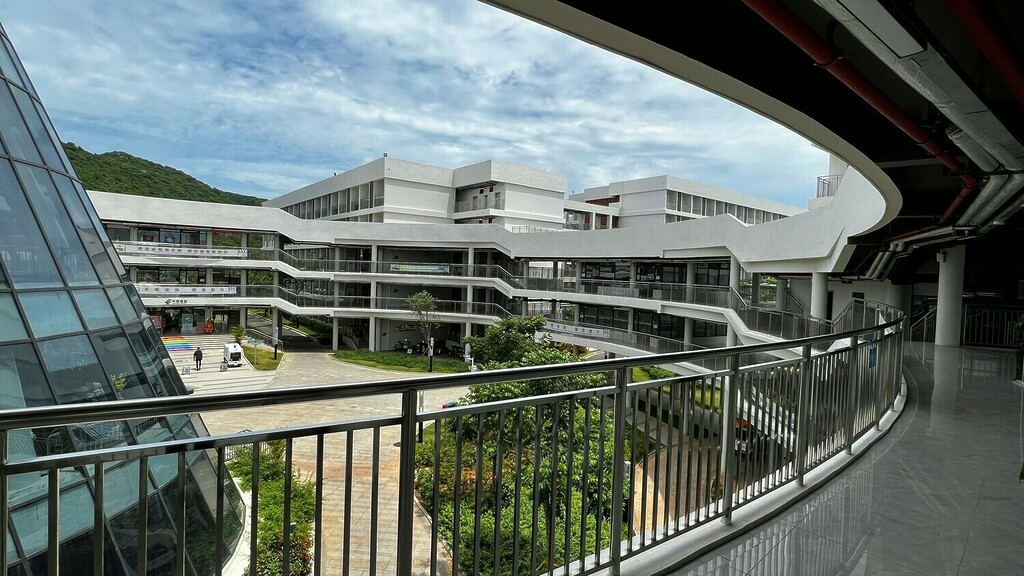
On 18 July, the German Bielefeld University of Applied Sciences (HSBI) made a big announcement: The founding of the first independent foreign university in China, located on the tropical island of Hainan. And the city of Bielefeld suddenly shifted into the focus of the debate on Sino-German academic relations.
While the University of Erlangen has recently confirmed that it will no longer accept scholarship holders from the China Scholarship Council and the German government urges universities to reconsider their partnerships with Confucius Institutes, the Hainan Bielefeld University of Applied Sciences (BiUH) is just getting started. In the winter semester, up to 140 students will study Computer Science and Digital Technologies at the bachelor level. According to HSBI, a new campus will provide space for up to 12,000 students in 2034.
What is particularly delicate from a political perspective: While German Research Minister Bettina Stark-Watzinger is known for her harsh tones towards China and even placed them in the China strategy, her ministry is co-funding the founding of the university through the “Transnational Education in Germany” program. The HSBI will receive around 1.9 million euros in taxpayers’ money until 2024.
In response to a query from Table.Media, Stark-Watzinger’s ministry has since distanced itself from the project: “Against the background of the China strategy, the Bielefeld University of Applied Sciences project is viewed critically and does not have any signaling effect,” said a spokesperson, adding that the German Academic Exchange Service (DAAD) already decided to fund the project in 2020 in the context of that time. “Bielefeld University now bears the responsibility associated with academic freedom. It must ensure its respect and minimize risks, including dual use,” the ministry demands.
The DAAD, too, is not really in a celebratory mood. A DAAD spokesperson said that the Bielefeld University of Applied Sciences is developing its international education project in Hainan, China, as an autonomous state university “with academic independence.” The project had been recommended by an academic commission for the Transnational Education program at the end of 2020. This funding recommendation is binding for the DAAD.
The HSBI President, Ingeborg Schramm-Woelk, and the President of the new BiUH, Juergen Kretschmann, expressed their disappointment over the political distancing in an interview with Table.Media. They acknowledge that changes have taken place in recent years, both in China itself and in the relationship with China. “However, it can still be gathered from the Federal Government’s current China strategy that cooperation in higher education is desired,” said Schramm-Woelk.
Juergen Kretschmann also believes that the project in the Hainan Special Economic Zone is in line with the new China strategy. About one-fifth of the global population lives in China, and the People’s Republic is the second largest economy in the world after the US, he said. The German government also emphasized in its China strategy that it would not be possible to solve the global, ecological and economic problems of the planet without China. “Cooperation must be on an equal footing and based on trust and must also be sensitive to the culture of the other side,” said Kretschmann, who has gained extensive experience with Sino-German cooperation in the coal mining industry.
The new university does indeed enjoy special freedoms by Chinese standards. The legal status of the Yangpu/Danzhou Economic Development Zone in the island’s north exempts the German-Chinese project from granting the Chinese partner 51 percent of the shares. Nevertheless, “given the increasing complexity in the cooperation with Chinese partners,” the independent scientific selection committee that evaluated the project already required an “exit strategy” as a condition for funding back in 2020, the DAAD stated. In addition, the DAAD would only support establishing bachelor’s degree programs, but not any research activities.
Ingeborg Schramm-Woelk objects to the term “exit strategy”. It was agreed that the project would be terminated if “things happen that are not compatible with higher education laws or German commercial law.” The university does not bear a significant financial risk, since no state funds were used for the project, she said. Only about 140,000 euros from surpluses of self-generated funds were used to establish a limited liability company, a Wholly Foreign Owned Enterprise (WFOE) and the Hainan Bielefeld University of Applied Sciences (BiUH) in the legal form of a “private non-profit organization.”
For Schramm-Woelk, the red lines for the project are precisely the points “that we have formulated in our memorandum of understanding.” This framework agreement states that BiUH is a higher education institution with independent legal status. “The university enjoys and guarantees academic freedom. All academic activities such as teaching and research serve peaceful purposes.”
The university president does not see any risk of dependence stemming from the high Chinese subsidies for construction and operation. She said the project aims to jointly build a university according to the German model. “We appoint the president, and the plan is to have a majority representation in all important bodies,” said Schramm-Woelk. She argues that it is important to remember in this context that there is no blueprint and that the project is unique. Without public funding, the project could not be implemented. “However, BiUH should be self-sustaining in the long term, and as a non-profit institution, the money generated will always benefit the students.”
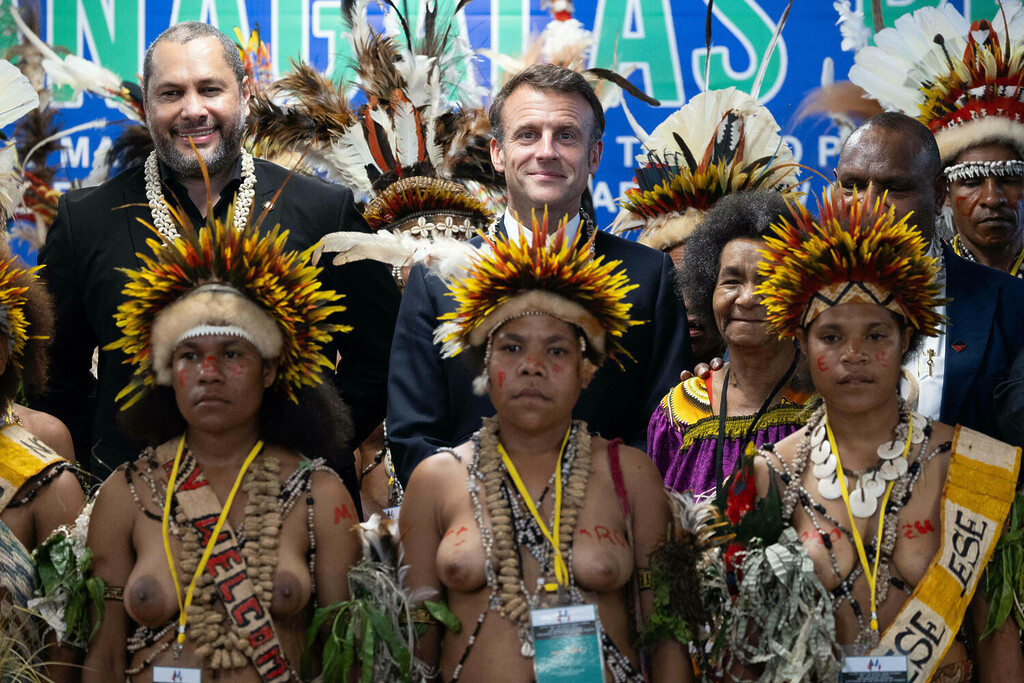
In the end, Emmanuel Macron used big words to underscore France’s security ambitions in the Indo-Pacific. At the closing conference with Papua New Guinea’s Prime Minister James Marape last Friday, Macron stressed that France did not want to get into “power games.” “Our objective is not at all to compete with China or the US.” Speaking in Vanuatu the day before, he had warned of “new imperialisms” in the Pacific. On other occasions, he and Defence Minister Sébastien Lecornu emphasized that France considers itself a balancing force in the Indo-Pacific.
Macron’s visit, accompanied by four of his ministers – including Defence Minister Sébastien Lecornu and Foreign Minister Catherine Colonna – was supposed to show that France could serve as a third pole in the region alongside China and the USA. As for the French overseas territory of New Caledonia, promises were made to station 200 additional soldiers and invest 150 million euros in a naval base. New Caledonia is also important because a quarter of the world’s nickel deposits are believed to be located there. France will also open its first embassy on the Polynesian island of Samoa and expand its extensive network of embassies in the Indo-Pacific.
But the hierarchy is clear: The US is still considered the primary security partner. In September 2021, Australia showed France that it prefers to rely on the US and the UK: Canberra canceled a submarine deal with the French, preferring to join the Aukus security alliance. US Secretary of State Antony Blinken assured New Zealand last Thursday that the “door is open” for New Zealand and other partners to join the alliance.
And two days before Macron, US Secretary of Defence Lloyd Austin negotiated with Papua’s Prime Minister Marape about a possible defense agreement that would, among other things, allow the presence of US soldiers on the island state for 15 years. Papua New Guinea is considered a strategically important country; most recently, China has massively strengthened its economic ties to the country.
Meanwhile, France attempts to publicly distance itself from the United States and position itself as a stabilizing third power in the Indo-Pacific. To this end, Paris increasingly relies on its own South Pacific initiatives, such as the South Pacific Defense Ministers’ Meeting and the Pacific Islands Forum. On France’s national day on 14 July, India’s Prime Minister Narendra Modi was Macron’s guest of honor at the military parade on the Champs-Élysées.
France defines the Indo-Pacific as an area stretching from the overseas territory of Mayotte off the coast of Madagascar to French Polynesia in the South Pacific. According to Macron, 8,000 soldiers are stationed there, and 1.5 million French people live in the region. More than a third of France’s trade outside the EU is with Indo-Pacific countries. The overseas territories in the Indian Ocean and the Pacific account for more than 90 percent of France’s exclusive economic zone – and make France the owner of the world’s second-largest maritime territory.
The plans for the upcoming military budgets include 13 billion euros for the French overseas territories. Most of them are in the Indo-Pacific. The 2024-2030 budget plans include six patrol boats and a corvette for the region.
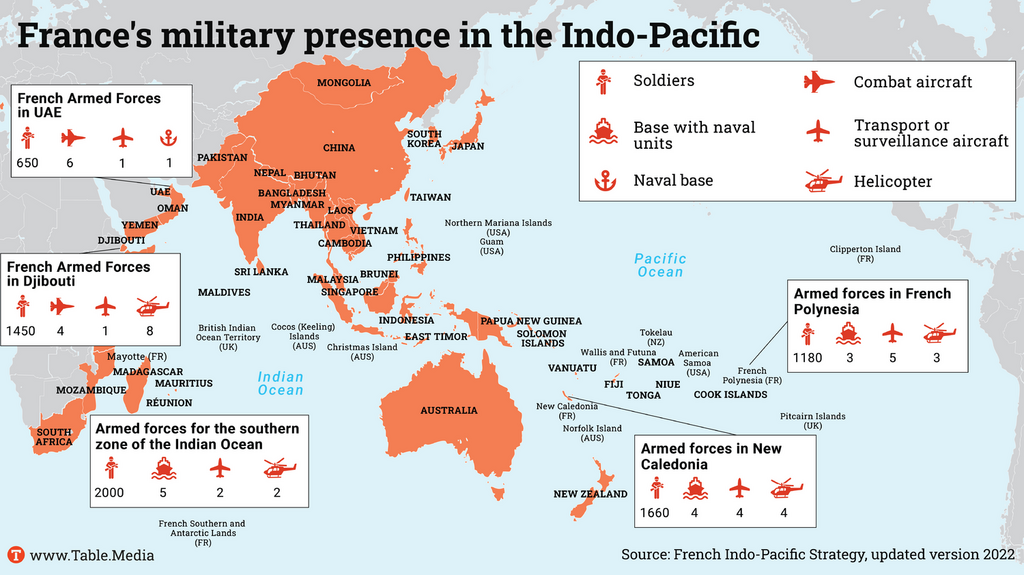
And yet: “You can, of course, show a presence with the patrol boats,” says Jacob Ross from the German Council on Foreign Relations (DGAP). “But you can’t send the signals that the Americans do when they send a carrier strike group into the region.”
On the other side is China. Here, too, France publicly maintains a distance. However, it does not want to completely offend its powerful partner from Beijing. In any case, economic cooperation with China remains close. On Sunday, French Finance Minister Bruno Le Maire said during a four-day visit to China that it would be “impossible” to cut all ties with the Chinese economy. “Decoupling is an illusion.”
But this is where the problem lies. The non-alignment stance is actually pushing France into precisely this China-US rivalry, writes Céline Pajon of the French think tank Institut Français des Relations Internationales (Ifri) in an essay on France’s Indo-Pacific strategy. France has “neither the capacity nor the diplomatic weight to play such a role.”
For example, France refrained from joining the US initiative “Partners in the Blue Pacific” not to send a negative signal to China. “France’s decision led to incongruity as countries such as Germany and South Korea joined the grouping, leaving France at risk of appearing isolated rather than independent.” Felix Heiduk from the German Institute for International and Security Affairs (SWP) sees France’s role as yet unclear. “There are different signals that contradict each other to some extent.”
In April, Macron upset several NATO partners after his visit to China, where he warned against getting “caught up in crises that are not ours” regarding the China-Taiwan-US conflict. A few weeks ago, the French president spoke out against a NATO office in Tokyo – again, because he did not want to offend China. “I think the impression is partly deceiving because of these very polemical statements by Macron. Ultimately, the cooperation is much closer at the operational level,” says DGAP expert Ross. However, he adds, there is “a certain discrepancy between the rhetoric and what the financial resources end up providing.”
Because the Pacific states have more than just security needs. “If you want to be an alternative pole, you must also provide the appropriate resources. Not just in the military sphere,” Heiduk says. “The primary interest of local actors is economic development, poverty, infrastructure, and very much the impact of climate change on many of these states.”
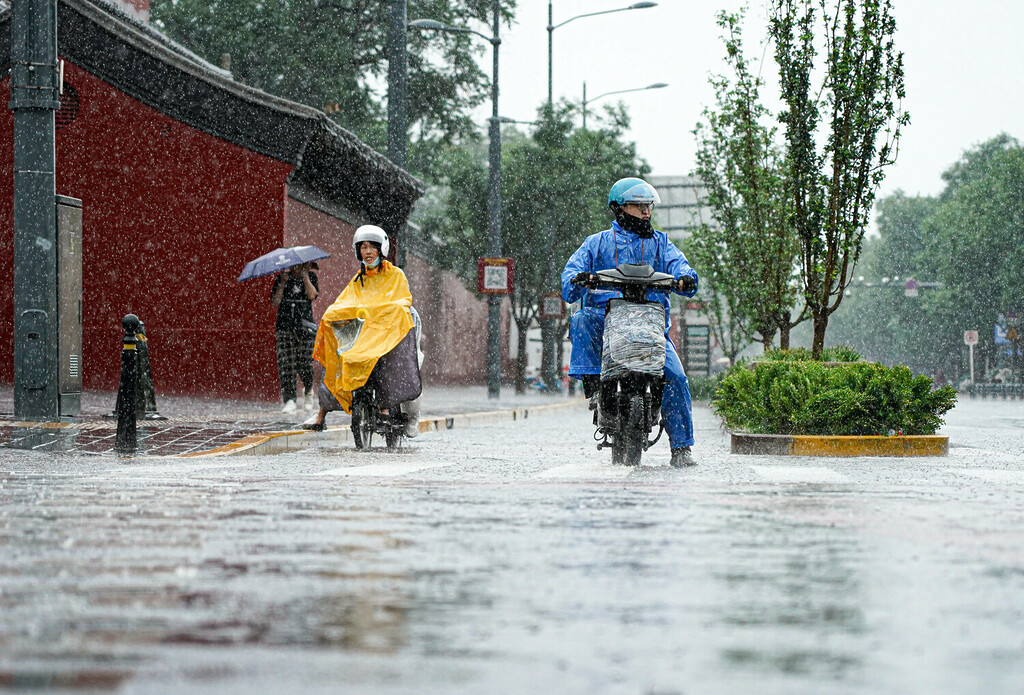
Due to heavy rain and flooding in the wake of Typhoon Doksuri, tens of thousands have been evacuated from their homes to safety in the capital Beijing. More than 31,000 people were affected by the evacuation measures, according to state media on Monday. Two bodies were recovered from rivers in the Mentougou district.
Videos on Twitter show how masses of water sweep away cars on the fifth ring road. More than 180 flights were canceled at both airports in Beijing this morning, and hundreds of flights were delayed, according to the Flight Master web application. Several trains were stuck overnight. Railroad employees provided travelers with food and drinking water.
According to the local weather service, Beijing experienced 170.9 millimeters of rainfall within 40 hours – as much as would normally fall during July. Although the storm weakened, the weather authority maintained the highest alert for heavy rainfall, as further rain and flooding are expected.
South of the capital, the impact of Doksuri was felt even more strongly. According to media reports, a truck driver was reported missing in the province of Hebei after two trucks fell from a collapsed bridge in the city of Baoding on Sunday. In Shijiazhuang, part of a freight railroad bridge was washed away by a flooded river.
Heavy rainfall also left parts of Shanxi province under water. Over the weekend, the typhoon had already caused widespread flooding in the southern province of Fujian, forcing hundreds of thousands to flee their homes.
Doksuri is one of the heaviest storms to hit China in recent years. Moreover, typhoons usually weaken once they reach the Beijing region in the country’s north. And meteorologists already warn of the next typhoon. Khanun is expected to hit the Chinese coast this week. flee/rtr
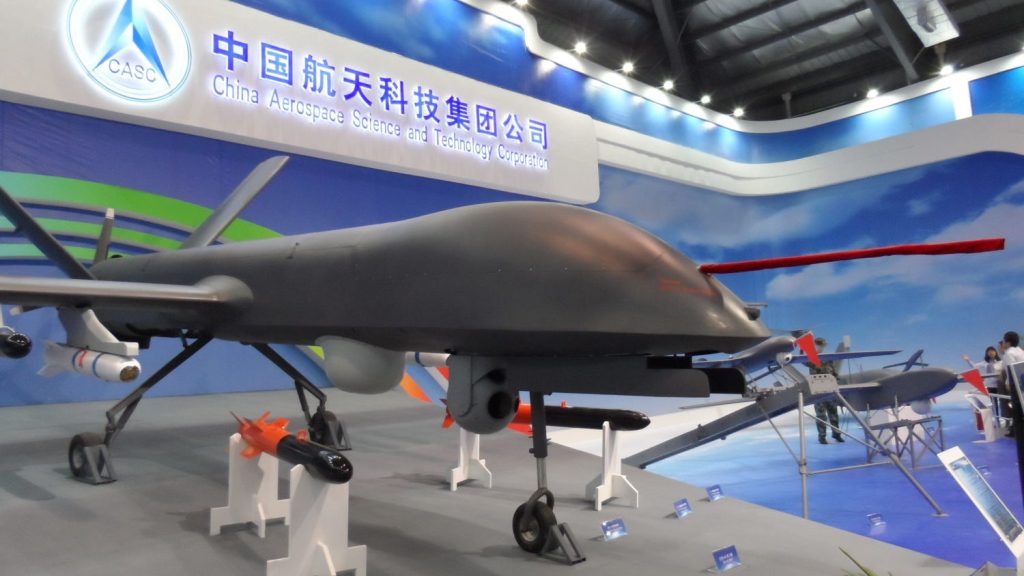
China will introduce new export restrictions on drones and drone-related equipment. This was announced by the Ministry of Commerce in Beijing on Monday. By restricting access to this technology, the ministry aims to protect China’s “national security and interests.” Explicitly mentioned in this context were the growing tensions with the United States.
The restrictions on equipment – including certain drone engines, lasers, communications equipment and anti-drone systems – will take effect Sept. 1. The restrictions would also affect some consumer drones, a Commerce Ministry spokesman said. “China’s modest expansion of the scope of its drone control this time is an important measure to demonstrate our stance as a responsible major country, to implement global security initiatives, and maintain world peace,” the spokesperson added.
The restrictions on drone exports came after China announced export controls on certain metals commonly used in chip manufacturing last month. Previously, the United States has taken steps to restrict China’s access to advanced chips.
China is considered a leader in the global drone market, supplying products to several markets, including the US. According to US data, more than 50 percent of drones sold in the US were made by the Chinese company DJI. In addition, public security agencies apparently favor using DJI drones. There have been repeated reports that Russia is using Chinese drones in the Ukraine war. China rejects these reports as false. rad
China struggles with weak consumption and an overall weak global economy. And this is also weighing on its industry. For instance, manufacturing activity in China declined for the fourth consecutive month in July. As the National Bureau of Statistics announced Monday, the official Purchasing Managers’ Index for the manufacturing sector (PMI) increased slightly. However, the value remained at 49.3, below the important 50-point mark that separates expansion and contraction.
The non-manufacturing sector also lost momentum. The Services PMI fell from 52.9 in June to 51.1, and analysts warn that the country could miss its modest growth target of around five percent in 2023 for the second year in a row if the economy remains weak.
Meanwhile, the State Council sets out to promote consumption, as decided by the Politburo. The purchase of EVs and tourism promotion are to be expanded. This is according to a document published on Monday. Residential rents are also to be lowered. The “fundamental role” of consumption in economic development should be brought to bear, it says. rtr
Italy’s Minister of Defense has called his country’s formal entry into the Belt & Road Initiative (BRI) an “improvised and atrocious” act. Joining the BRI has multiplied China’s exports to Italy, but not Italian exports to the People’s Republic, Guido Crosetto said in an interview with the Italian newspaper Corriere della Sera. He added that the question now is how Italy can leave the BRI without damaging relations with Beijing. “Because it is true that China is a competitor, but it is also a partner,” Crosetto said. Such deliberations from Rome to leave the project are not new, but with Crosetto, a minister now clearly spoke out against the BRI.
In 2019, Italy became the first and so far only G7 nation to formally join the BRI. However, the cooperation agreement, a memorandum of understanding (MoU), expires in March 2024. The government of Prime Minister Giorgia Meloni will soon have to decide whether to renew the agreement.
“We will make a decision before December,” Meloni told US broadcaster Fox News in an interview aired Sunday, adding that the issue must be discussed with the Chinese government and within the Italian parliament. It is a “paradox” that Italy is part of the New Silk Road but not the G7 country with the largest trade with China, the right-wing populist said. This shows that good relations with Beijing are possible even without the New Silk Road, she added. Meloni already indicated during the election campaign that she would prefer to lead Italy out of the BRI or not to extend the cooperation. ari
The Japanese car manufacturer Toyota wants to go on the offensive on China’s EV market. On Monday, the company announced plans to accelerate the development of electric drives and digital dashboards including software (smart cockpits). Toyota is thus reacting to the growing competitive pressure from Chinese manufacturers. The company wants to align its vehicles more closely with the wishes of Chinese customers, it said.
Toyota is taking a similar approach as Volkswagen, pooling engineers from the development departments of its joint ventures with the Chinese FAW Group, Guangzhou Automobile Group and the new Chinese market leader BYD for individual projects. The Japanese are not only focusing on battery-powered vehicles, but also on plug-in hybrids that can be charged from a power socket, classic hybrid cars and fuel cell engines that use hydrogen.
With its realignment, Toyota follows a trend in the automotive industry to adapt more to the characteristics of the Chinese market. This is one of the reasons why Volkswagen has acquired a stake in the Chinese automaker Xpeng and expanded its cooperation with the state-owned joint venture partner SAIC. rtr/grz

As a child, Anno Dederichs’ parents were gifted picture scrolls by a visiting scientist from Chengdu. Drawn on them were the mist-shrouded mountains of Sichuan Province. The image of these mountains burned itself into Dederich’s memory. It was not until years later that he saw them with his own eyes on his first trip to China.
At the time, he had come into closer contact with China through the traditional martial art of wushu and traveled the country with his training group. “I was surprised how well the picture scrolls actually captured the mood in the mountains,” he recalls.
Back in Germany, he studied sinology and sociology in Tuebingen, then spent a semester abroad at Peking University and an academic year at Nanjing University. “Studying in China was formative because it brought me closer to the country and its people and thus triggered a fundamental engagement with different perspectives.”
At that time, his research interest also crystallized; the self-perception and foreign perception of Germany’s engagement with China – and vice versa. More precisely: How is China perceived in the West? How does China perceive itself and its representation to the outside world? And what is true the other way around for Germany?
After earning his Ph.D. in sociology, Dederichs joined the China Centrum Tuebingen (CCT), where he still works as a research associate. He has stayed true to his focus, analyzing German discourses on China and studying the perceptions and future expectations of Chinese students in Germany.
“The portrayal of China could be well observed, for example, in the debate about anti-Asian racism during the Covid pandemic,” says Dederichs. Various narratives used in the media’s portrayal of China can be traced back to colonial times, he says. However, Dederichs perceives a general lack of communication, which has existed since the pandemic, as particularly dramatic. “Since then, people have mainly been talking about each other, but not to each other. We are only now really feeling the consequences of this lack of communication, the alienation it has caused.”
With his work at the CCT and the ChinaForum Tuebingen, which belongs to the center and is a project financed by the Ministry of Education to increase China expertise at German universities, Dederichs is contributing to counter this development. He coordinates scientific collaborations, exchange programs for students and lecture series, and leads research and publication projects. In this way, he creates more accessible communication channels. “It’s important to have these exchange opportunities so that people can give each other the broadest possible picture of their positions and perceptions of the world – including beyond big politics.” Svenja Napp
Gunnar Wiegand, outgoing Asia Director of the European External Action Service (EEAS), will become a visiting professor at the College of Europe in Bruges, Belgium, after the summer break. There, he will become part of the Department of EU International Relations and Diplomacy Studies. Wiegand joined the EEAS in 2016. A successor has not yet been officially appointed.
Jochen Stahnke has been appointed the new China correspondent of the German daily Frankfurter Allgemeine Zeitung. After stints in Frankfurt, Tel Aviv and Berlin, Stahnke now reports from Beijing on China, Taiwan and North Korea.
Is something changing in your organization? Let us know at heads@table.media!

Comic characters brought to life: Fans of two-dimensional comic book heroes meet at the Anime and Game Carnival in Yantai. Over the past five years, China’s cosplay market has grown by an average of 10.4 percent. By 2026, it could reach a volume of 100 billion yuan.
A few days ago, the German Bielefeld University caused quite a stir: It plans to break new ground in the Chinese special economic zone of Hainan with the first independent foreign university in China.
But Tim Gabel shows that even before teaching actually started, the euphoria has already faded – at least among political sponsors. In response to an inquiry from Table.Media, the German Federal Ministry of Education and Research distanced itself from the project: In light of Germany’s China strategy, it is critical of the Bielefeld University’s project. The German Academic Exchange Service is similarly crestfallen. The project leaders, on the other hand, express resilience.
France also has big plans – in the Indo-Pacific. President Macron traveled to the region specifically to position his country as an alternative to China and the US. With more soldiers and more money, France aims to become a third pole in the region.
Gabriel Bub shows that Macron will not get very far with these means: After all, the US is the undisputed leader when it comes to security policy, and China scores points economically.


On 18 July, the German Bielefeld University of Applied Sciences (HSBI) made a big announcement: The founding of the first independent foreign university in China, located on the tropical island of Hainan. And the city of Bielefeld suddenly shifted into the focus of the debate on Sino-German academic relations.
While the University of Erlangen has recently confirmed that it will no longer accept scholarship holders from the China Scholarship Council and the German government urges universities to reconsider their partnerships with Confucius Institutes, the Hainan Bielefeld University of Applied Sciences (BiUH) is just getting started. In the winter semester, up to 140 students will study Computer Science and Digital Technologies at the bachelor level. According to HSBI, a new campus will provide space for up to 12,000 students in 2034.
What is particularly delicate from a political perspective: While German Research Minister Bettina Stark-Watzinger is known for her harsh tones towards China and even placed them in the China strategy, her ministry is co-funding the founding of the university through the “Transnational Education in Germany” program. The HSBI will receive around 1.9 million euros in taxpayers’ money until 2024.
In response to a query from Table.Media, Stark-Watzinger’s ministry has since distanced itself from the project: “Against the background of the China strategy, the Bielefeld University of Applied Sciences project is viewed critically and does not have any signaling effect,” said a spokesperson, adding that the German Academic Exchange Service (DAAD) already decided to fund the project in 2020 in the context of that time. “Bielefeld University now bears the responsibility associated with academic freedom. It must ensure its respect and minimize risks, including dual use,” the ministry demands.
The DAAD, too, is not really in a celebratory mood. A DAAD spokesperson said that the Bielefeld University of Applied Sciences is developing its international education project in Hainan, China, as an autonomous state university “with academic independence.” The project had been recommended by an academic commission for the Transnational Education program at the end of 2020. This funding recommendation is binding for the DAAD.
The HSBI President, Ingeborg Schramm-Woelk, and the President of the new BiUH, Juergen Kretschmann, expressed their disappointment over the political distancing in an interview with Table.Media. They acknowledge that changes have taken place in recent years, both in China itself and in the relationship with China. “However, it can still be gathered from the Federal Government’s current China strategy that cooperation in higher education is desired,” said Schramm-Woelk.
Juergen Kretschmann also believes that the project in the Hainan Special Economic Zone is in line with the new China strategy. About one-fifth of the global population lives in China, and the People’s Republic is the second largest economy in the world after the US, he said. The German government also emphasized in its China strategy that it would not be possible to solve the global, ecological and economic problems of the planet without China. “Cooperation must be on an equal footing and based on trust and must also be sensitive to the culture of the other side,” said Kretschmann, who has gained extensive experience with Sino-German cooperation in the coal mining industry.
The new university does indeed enjoy special freedoms by Chinese standards. The legal status of the Yangpu/Danzhou Economic Development Zone in the island’s north exempts the German-Chinese project from granting the Chinese partner 51 percent of the shares. Nevertheless, “given the increasing complexity in the cooperation with Chinese partners,” the independent scientific selection committee that evaluated the project already required an “exit strategy” as a condition for funding back in 2020, the DAAD stated. In addition, the DAAD would only support establishing bachelor’s degree programs, but not any research activities.
Ingeborg Schramm-Woelk objects to the term “exit strategy”. It was agreed that the project would be terminated if “things happen that are not compatible with higher education laws or German commercial law.” The university does not bear a significant financial risk, since no state funds were used for the project, she said. Only about 140,000 euros from surpluses of self-generated funds were used to establish a limited liability company, a Wholly Foreign Owned Enterprise (WFOE) and the Hainan Bielefeld University of Applied Sciences (BiUH) in the legal form of a “private non-profit organization.”
For Schramm-Woelk, the red lines for the project are precisely the points “that we have formulated in our memorandum of understanding.” This framework agreement states that BiUH is a higher education institution with independent legal status. “The university enjoys and guarantees academic freedom. All academic activities such as teaching and research serve peaceful purposes.”
The university president does not see any risk of dependence stemming from the high Chinese subsidies for construction and operation. She said the project aims to jointly build a university according to the German model. “We appoint the president, and the plan is to have a majority representation in all important bodies,” said Schramm-Woelk. She argues that it is important to remember in this context that there is no blueprint and that the project is unique. Without public funding, the project could not be implemented. “However, BiUH should be self-sustaining in the long term, and as a non-profit institution, the money generated will always benefit the students.”

In the end, Emmanuel Macron used big words to underscore France’s security ambitions in the Indo-Pacific. At the closing conference with Papua New Guinea’s Prime Minister James Marape last Friday, Macron stressed that France did not want to get into “power games.” “Our objective is not at all to compete with China or the US.” Speaking in Vanuatu the day before, he had warned of “new imperialisms” in the Pacific. On other occasions, he and Defence Minister Sébastien Lecornu emphasized that France considers itself a balancing force in the Indo-Pacific.
Macron’s visit, accompanied by four of his ministers – including Defence Minister Sébastien Lecornu and Foreign Minister Catherine Colonna – was supposed to show that France could serve as a third pole in the region alongside China and the USA. As for the French overseas territory of New Caledonia, promises were made to station 200 additional soldiers and invest 150 million euros in a naval base. New Caledonia is also important because a quarter of the world’s nickel deposits are believed to be located there. France will also open its first embassy on the Polynesian island of Samoa and expand its extensive network of embassies in the Indo-Pacific.
But the hierarchy is clear: The US is still considered the primary security partner. In September 2021, Australia showed France that it prefers to rely on the US and the UK: Canberra canceled a submarine deal with the French, preferring to join the Aukus security alliance. US Secretary of State Antony Blinken assured New Zealand last Thursday that the “door is open” for New Zealand and other partners to join the alliance.
And two days before Macron, US Secretary of Defence Lloyd Austin negotiated with Papua’s Prime Minister Marape about a possible defense agreement that would, among other things, allow the presence of US soldiers on the island state for 15 years. Papua New Guinea is considered a strategically important country; most recently, China has massively strengthened its economic ties to the country.
Meanwhile, France attempts to publicly distance itself from the United States and position itself as a stabilizing third power in the Indo-Pacific. To this end, Paris increasingly relies on its own South Pacific initiatives, such as the South Pacific Defense Ministers’ Meeting and the Pacific Islands Forum. On France’s national day on 14 July, India’s Prime Minister Narendra Modi was Macron’s guest of honor at the military parade on the Champs-Élysées.
France defines the Indo-Pacific as an area stretching from the overseas territory of Mayotte off the coast of Madagascar to French Polynesia in the South Pacific. According to Macron, 8,000 soldiers are stationed there, and 1.5 million French people live in the region. More than a third of France’s trade outside the EU is with Indo-Pacific countries. The overseas territories in the Indian Ocean and the Pacific account for more than 90 percent of France’s exclusive economic zone – and make France the owner of the world’s second-largest maritime territory.
The plans for the upcoming military budgets include 13 billion euros for the French overseas territories. Most of them are in the Indo-Pacific. The 2024-2030 budget plans include six patrol boats and a corvette for the region.

And yet: “You can, of course, show a presence with the patrol boats,” says Jacob Ross from the German Council on Foreign Relations (DGAP). “But you can’t send the signals that the Americans do when they send a carrier strike group into the region.”
On the other side is China. Here, too, France publicly maintains a distance. However, it does not want to completely offend its powerful partner from Beijing. In any case, economic cooperation with China remains close. On Sunday, French Finance Minister Bruno Le Maire said during a four-day visit to China that it would be “impossible” to cut all ties with the Chinese economy. “Decoupling is an illusion.”
But this is where the problem lies. The non-alignment stance is actually pushing France into precisely this China-US rivalry, writes Céline Pajon of the French think tank Institut Français des Relations Internationales (Ifri) in an essay on France’s Indo-Pacific strategy. France has “neither the capacity nor the diplomatic weight to play such a role.”
For example, France refrained from joining the US initiative “Partners in the Blue Pacific” not to send a negative signal to China. “France’s decision led to incongruity as countries such as Germany and South Korea joined the grouping, leaving France at risk of appearing isolated rather than independent.” Felix Heiduk from the German Institute for International and Security Affairs (SWP) sees France’s role as yet unclear. “There are different signals that contradict each other to some extent.”
In April, Macron upset several NATO partners after his visit to China, where he warned against getting “caught up in crises that are not ours” regarding the China-Taiwan-US conflict. A few weeks ago, the French president spoke out against a NATO office in Tokyo – again, because he did not want to offend China. “I think the impression is partly deceiving because of these very polemical statements by Macron. Ultimately, the cooperation is much closer at the operational level,” says DGAP expert Ross. However, he adds, there is “a certain discrepancy between the rhetoric and what the financial resources end up providing.”
Because the Pacific states have more than just security needs. “If you want to be an alternative pole, you must also provide the appropriate resources. Not just in the military sphere,” Heiduk says. “The primary interest of local actors is economic development, poverty, infrastructure, and very much the impact of climate change on many of these states.”

Due to heavy rain and flooding in the wake of Typhoon Doksuri, tens of thousands have been evacuated from their homes to safety in the capital Beijing. More than 31,000 people were affected by the evacuation measures, according to state media on Monday. Two bodies were recovered from rivers in the Mentougou district.
Videos on Twitter show how masses of water sweep away cars on the fifth ring road. More than 180 flights were canceled at both airports in Beijing this morning, and hundreds of flights were delayed, according to the Flight Master web application. Several trains were stuck overnight. Railroad employees provided travelers with food and drinking water.
According to the local weather service, Beijing experienced 170.9 millimeters of rainfall within 40 hours – as much as would normally fall during July. Although the storm weakened, the weather authority maintained the highest alert for heavy rainfall, as further rain and flooding are expected.
South of the capital, the impact of Doksuri was felt even more strongly. According to media reports, a truck driver was reported missing in the province of Hebei after two trucks fell from a collapsed bridge in the city of Baoding on Sunday. In Shijiazhuang, part of a freight railroad bridge was washed away by a flooded river.
Heavy rainfall also left parts of Shanxi province under water. Over the weekend, the typhoon had already caused widespread flooding in the southern province of Fujian, forcing hundreds of thousands to flee their homes.
Doksuri is one of the heaviest storms to hit China in recent years. Moreover, typhoons usually weaken once they reach the Beijing region in the country’s north. And meteorologists already warn of the next typhoon. Khanun is expected to hit the Chinese coast this week. flee/rtr

China will introduce new export restrictions on drones and drone-related equipment. This was announced by the Ministry of Commerce in Beijing on Monday. By restricting access to this technology, the ministry aims to protect China’s “national security and interests.” Explicitly mentioned in this context were the growing tensions with the United States.
The restrictions on equipment – including certain drone engines, lasers, communications equipment and anti-drone systems – will take effect Sept. 1. The restrictions would also affect some consumer drones, a Commerce Ministry spokesman said. “China’s modest expansion of the scope of its drone control this time is an important measure to demonstrate our stance as a responsible major country, to implement global security initiatives, and maintain world peace,” the spokesperson added.
The restrictions on drone exports came after China announced export controls on certain metals commonly used in chip manufacturing last month. Previously, the United States has taken steps to restrict China’s access to advanced chips.
China is considered a leader in the global drone market, supplying products to several markets, including the US. According to US data, more than 50 percent of drones sold in the US were made by the Chinese company DJI. In addition, public security agencies apparently favor using DJI drones. There have been repeated reports that Russia is using Chinese drones in the Ukraine war. China rejects these reports as false. rad
China struggles with weak consumption and an overall weak global economy. And this is also weighing on its industry. For instance, manufacturing activity in China declined for the fourth consecutive month in July. As the National Bureau of Statistics announced Monday, the official Purchasing Managers’ Index for the manufacturing sector (PMI) increased slightly. However, the value remained at 49.3, below the important 50-point mark that separates expansion and contraction.
The non-manufacturing sector also lost momentum. The Services PMI fell from 52.9 in June to 51.1, and analysts warn that the country could miss its modest growth target of around five percent in 2023 for the second year in a row if the economy remains weak.
Meanwhile, the State Council sets out to promote consumption, as decided by the Politburo. The purchase of EVs and tourism promotion are to be expanded. This is according to a document published on Monday. Residential rents are also to be lowered. The “fundamental role” of consumption in economic development should be brought to bear, it says. rtr
Italy’s Minister of Defense has called his country’s formal entry into the Belt & Road Initiative (BRI) an “improvised and atrocious” act. Joining the BRI has multiplied China’s exports to Italy, but not Italian exports to the People’s Republic, Guido Crosetto said in an interview with the Italian newspaper Corriere della Sera. He added that the question now is how Italy can leave the BRI without damaging relations with Beijing. “Because it is true that China is a competitor, but it is also a partner,” Crosetto said. Such deliberations from Rome to leave the project are not new, but with Crosetto, a minister now clearly spoke out against the BRI.
In 2019, Italy became the first and so far only G7 nation to formally join the BRI. However, the cooperation agreement, a memorandum of understanding (MoU), expires in March 2024. The government of Prime Minister Giorgia Meloni will soon have to decide whether to renew the agreement.
“We will make a decision before December,” Meloni told US broadcaster Fox News in an interview aired Sunday, adding that the issue must be discussed with the Chinese government and within the Italian parliament. It is a “paradox” that Italy is part of the New Silk Road but not the G7 country with the largest trade with China, the right-wing populist said. This shows that good relations with Beijing are possible even without the New Silk Road, she added. Meloni already indicated during the election campaign that she would prefer to lead Italy out of the BRI or not to extend the cooperation. ari
The Japanese car manufacturer Toyota wants to go on the offensive on China’s EV market. On Monday, the company announced plans to accelerate the development of electric drives and digital dashboards including software (smart cockpits). Toyota is thus reacting to the growing competitive pressure from Chinese manufacturers. The company wants to align its vehicles more closely with the wishes of Chinese customers, it said.
Toyota is taking a similar approach as Volkswagen, pooling engineers from the development departments of its joint ventures with the Chinese FAW Group, Guangzhou Automobile Group and the new Chinese market leader BYD for individual projects. The Japanese are not only focusing on battery-powered vehicles, but also on plug-in hybrids that can be charged from a power socket, classic hybrid cars and fuel cell engines that use hydrogen.
With its realignment, Toyota follows a trend in the automotive industry to adapt more to the characteristics of the Chinese market. This is one of the reasons why Volkswagen has acquired a stake in the Chinese automaker Xpeng and expanded its cooperation with the state-owned joint venture partner SAIC. rtr/grz

As a child, Anno Dederichs’ parents were gifted picture scrolls by a visiting scientist from Chengdu. Drawn on them were the mist-shrouded mountains of Sichuan Province. The image of these mountains burned itself into Dederich’s memory. It was not until years later that he saw them with his own eyes on his first trip to China.
At the time, he had come into closer contact with China through the traditional martial art of wushu and traveled the country with his training group. “I was surprised how well the picture scrolls actually captured the mood in the mountains,” he recalls.
Back in Germany, he studied sinology and sociology in Tuebingen, then spent a semester abroad at Peking University and an academic year at Nanjing University. “Studying in China was formative because it brought me closer to the country and its people and thus triggered a fundamental engagement with different perspectives.”
At that time, his research interest also crystallized; the self-perception and foreign perception of Germany’s engagement with China – and vice versa. More precisely: How is China perceived in the West? How does China perceive itself and its representation to the outside world? And what is true the other way around for Germany?
After earning his Ph.D. in sociology, Dederichs joined the China Centrum Tuebingen (CCT), where he still works as a research associate. He has stayed true to his focus, analyzing German discourses on China and studying the perceptions and future expectations of Chinese students in Germany.
“The portrayal of China could be well observed, for example, in the debate about anti-Asian racism during the Covid pandemic,” says Dederichs. Various narratives used in the media’s portrayal of China can be traced back to colonial times, he says. However, Dederichs perceives a general lack of communication, which has existed since the pandemic, as particularly dramatic. “Since then, people have mainly been talking about each other, but not to each other. We are only now really feeling the consequences of this lack of communication, the alienation it has caused.”
With his work at the CCT and the ChinaForum Tuebingen, which belongs to the center and is a project financed by the Ministry of Education to increase China expertise at German universities, Dederichs is contributing to counter this development. He coordinates scientific collaborations, exchange programs for students and lecture series, and leads research and publication projects. In this way, he creates more accessible communication channels. “It’s important to have these exchange opportunities so that people can give each other the broadest possible picture of their positions and perceptions of the world – including beyond big politics.” Svenja Napp
Gunnar Wiegand, outgoing Asia Director of the European External Action Service (EEAS), will become a visiting professor at the College of Europe in Bruges, Belgium, after the summer break. There, he will become part of the Department of EU International Relations and Diplomacy Studies. Wiegand joined the EEAS in 2016. A successor has not yet been officially appointed.
Jochen Stahnke has been appointed the new China correspondent of the German daily Frankfurter Allgemeine Zeitung. After stints in Frankfurt, Tel Aviv and Berlin, Stahnke now reports from Beijing on China, Taiwan and North Korea.
Is something changing in your organization? Let us know at heads@table.media!

Comic characters brought to life: Fans of two-dimensional comic book heroes meet at the Anime and Game Carnival in Yantai. Over the past five years, China’s cosplay market has grown by an average of 10.4 percent. By 2026, it could reach a volume of 100 billion yuan.
